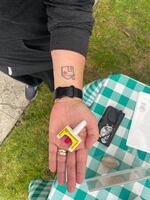
Nurse Susannah Lujan-Bear holds out a dose of Naloxone during an overdose-reversal education event Aug. 29, 2023 at the OHSU Marquam Hill farmers market.
Amelia Templeton / OPB
Nurses at Oregon Health & Science University are encouraging Oregonians to request a prescription for Naloxone on their next visit to a pharmacy or primary care doctor, particularly if they are parents or spending time around young adults.
Oregon has seen a sharp increase in fentanyl-related overdose deaths among young people ages 15 to 19.
Related: ‘It’s crazy out there’: The reasons behind Oregon’s deepening drug crisis
Also known as Narcan, Naloxone is the drug that can reverse an opioid overdose. It’s safe and easy to use: You just squirt it up a person’s nose.
Susannah Lujan-Bear, an addiction medicine nurse and a mother of two young adults in their 20s, keeps a dose of Naloxone in the glove compartment of her car, another in her backpack and a third dose on top of her dresser at home.
“My kids know how to use it and they know where it is,” she said. “Honestly, if you live in Portland, Oregon, you don’t know when you might be someone who comes across someone who is overdosing.”
Lujan-Bear said parents may not imagine their child is at risk. But it’s normal for young people to get curious and experiment with drugs, without realizing what they’re trying contains fentanyl.
It’s cheap to manufacture, powerful and addictive. It’s become a common addition to counterfeit pain pills and all sorts of other illicit drugs.
And many fatal overdoses involve bystanders who could help if they’re prepared.
“If they’re at a party, wouldn’t it be great if they had Naloxone if it was needed, and if their friends did?” Lujan-Bear said.
Last week, Lujan-Bear and her colleagues took their effort to give more people the confidence and tools to intervene to the farmers market on OHSU’s Marquam Hill campus.
Sitting next to the vendors selling peaches and mushrooms, they chatted with medical students and hospital staff, explaining that Naloxone is safe to give, and won’t harm someone who isn’t overdosing. It’s better to err on the side of administering it, they said.
Oregon law allows pharmacists to prescribe Naloxone, also known by the brand name Narcan. Oregonians can get it at many participating retail pharmacies, like Fred Meyer and Costco. It’s kept behind the counter and you’ll need to ask the pharmacist, fill out a short questionnaire, and pay for it. You can pay out of pocket or bill insurance. Most commercial insurance will charge a copay, around $30, according to the OHSU nurses. It’s free for patients on Medicaid, Medicare and some student health plans.
Albert Romo, a health unit coordinator at the hospital, stopped by the booth and said he’d like to learn more. Nurse Kathleen Young explained the signs of an overdose, and what to do.
Look for gurgling or reduced breathing, bluish lips and pupils that look like a pinpoint, she said. If a person is unresponsive, call 911 first. Then, tell the person you’re going to give them Naloxone, whether or not you think they can hear you.
“One of the most common questions that people ask if the patient isn’t breathing: How does that medication work? It is absorbed into the nasal membrane and it goes into the bloodstream,” Young explained.
After you administer a first dose, wait two minutes to see if a person revives.
“If you are comfortable, we always say if someone isn’t breathing, you give rescue breathing one breath every five seconds,” Young said.
After two minutes, if a person hasn’t revived, give a second dose in the other nostril. Fentanyl is 50-100 times more powerful than heroin and morphine, so it may take two doses of Naloxone to revive someone.
Young explained that Naloxone works by pushing the opioids off the receptors in a person’s brain. However, fentanyl can linger in the bloodstream. The effect of Naloxone only lasts 30 to 90 minutes, at which point a person can slip back into an overdose again. She told Romo it’s important to stay with someone until emergency services arrive, if you feel safe doing that.
Romo thanked her. He said he thinks he’d like to start carrying Naloxone. He has been in recovery for 18 years, and does work in the recovery community, which has given him a sense of responsibility to others struggling with addiction.
“You have to give it away,” Romo said, “to keep it.”
